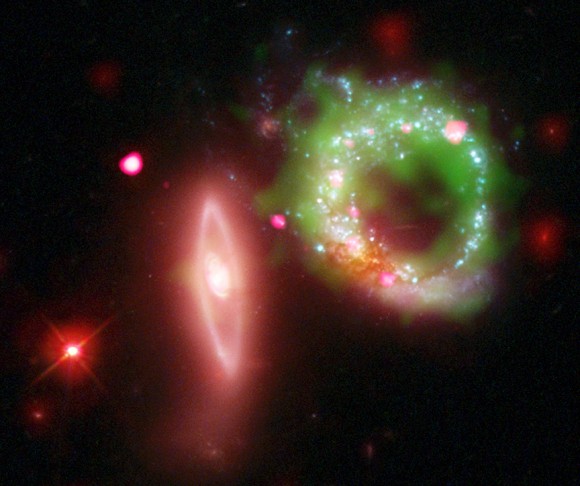Several space telescopes including Spitzer and Hubble joined together to create an image of two galaxies whose collision created a shock wave around which many stars are born and die

In preparation for Valentine's Day starting this Monday, NASA presents a ring, not of diamonds but of black holes. The image composite of ARP 147, a pair of merging galaxies located 430 million light-years from Earth, showing X-rays from the Chandra observatory satellite (pink) and optical data from the Hubble Space Telescope (red, green, and blue) was produced by the Space Telescope Science Center in Baltimore.
ARP 147 contains remnants of a spiral galaxy (right) merging with the elliptical galaxy on the left. This collision produced any spreader of star formation visible in the image as a blue ring containing a wealth of massive young stars. These stars undergo their rapid evolution over several million years and explode in supernovae, leaving behind neutron stars and black holes.
Some neutron stars have companion stars and may be X-ray sources as they pull material from their companions. Nine X-ray sources scattered around the ring of ARP 147 are so bright that they must be black holes with masses 10-20 times the mass of the Sun.
X-ray sources can also be found in the nuclei of the red galaxy on the left and they are apparently driven by the black hole in their center. These sources are not observed in the integrated image but are easily seen in the X-rays. Other objects not related to ARP 147 but also interesting - the star on the lower left of the image and a quasar in the background visible as a pink source above the red galaxy slightly to its left.
Infrared observations made by the Spitzer Space Telescope and ultraviolet observations made by the Galaxy Finder (GALEX) made it possible to estimate the rate of star formation in the ring. These estimates, combined with the use of models on the evolution of binary stars, allowed the researchers to conclude that most of the massive star formation process ended about 15 million years ago, according to Earth's timetable.

5 תגובות
I don't see the holes themselves, is it just me or because they are black?
Also with FF and I see a title.
Check your adblock settings
Actually there is no advertising in the title, so it's strange.
It may be a local problem for you, I'm a free surfer on Firefox, even right now as I'm writing this comment and I haven't encountered any problem.
The website title still does not appear in Firefox (maybe it is filtered as if it is an advertisement?)
It is also not possible to click on images to enlarge.
In any case, this is a rare site! Keep it up father..